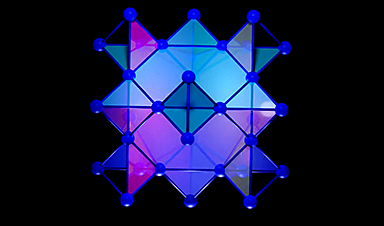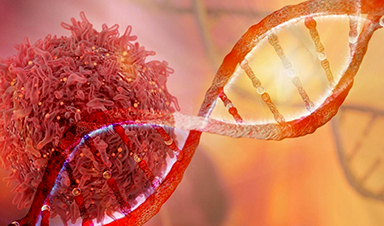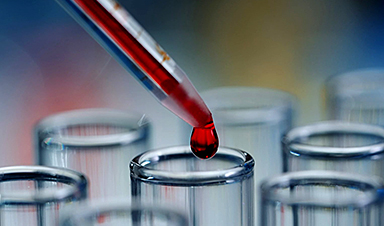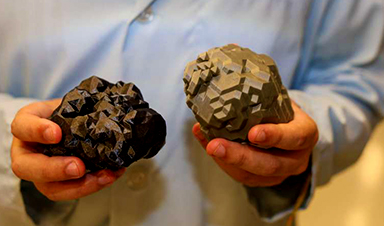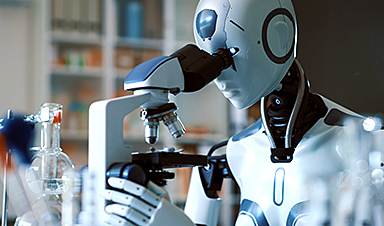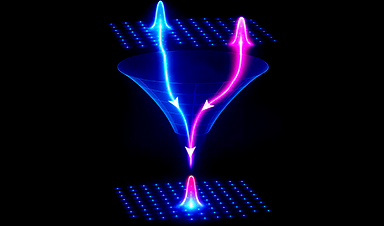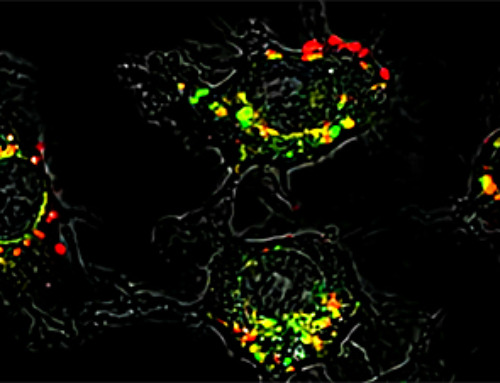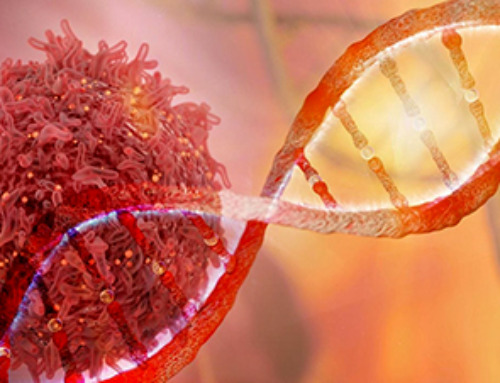Electrons move through a conducting material like commuters at the height of Manhattan rush hour. The charged particles may jostle and bump against each other, but for the most part, they’re unconcerned with other electrons as they hurtle forward, each with their own energy.
Now, physicists at MIT have successfully trapped electrons in a pure crystal. It is the first time scientists have achieved an electronic flat band in a three-dimensional material. With some chemical manipulation, the researchers also showed they could transform the crystal into a superconductor—a material that conducts electricity with zero resistance.
The crystal’s atomic geometry makes the electrons’ trapped state possible. The crystal, which the physicists synthesized, has an arrangement of atoms that resembles the woven patterns in “kagome,” the Japanese art of basket weaving. In this specific geometry, the researchers found that electrons were “caged,” rather than jumping between atoms and settled into the same energy band.
The researchers say that this flat-band state can be realized with virtually any combination of atoms—as long as they are arranged in this kagome-inspired 3D geometry. The results in Nature provide a new way for scientists to explore rare electronic states in three-dimensional materials. These materials might someday be optimized to enable ultra-efficient power lines, supercomputing quantum bits, and faster, smarter electronic devices.
“Now that we know we can make a flat band from this geometry, we have a big motivation to study other structures that might have other new physics that could be a platform for new technologies,” says study author Joseph Checkelsky, associate professor of physics.
Setting a 3-D trap
In recent years, physicists have successfully trapped electrons and confirmed their electronic flat-band state in two-dimensional materials. However, scientists have found that electrons that are trapped in two dimensions can easily escape out of the third, making flat-band states difficult to maintain in 2D.
In their new study, Checkelsky, Comin, and their colleagues looked to realize flat bands in 3D materials, such that electrons would be trapped in all three dimensions and any exotic electronic states could be more stably maintained. They had an idea that kagome patterns might play a role.
In previous work, the team observed trapped electrons in a two-dimensional lattice of atoms that resembled some kagome designs. When the atoms were arranged in a pattern of interconnected, corner-sharing triangles, electrons were confined within the hexagonal space between triangles, rather than hopping across the lattice. But, like others, the researchers found that the electrons could escape up and out of the lattice, through the third dimension.
The team wondered: Could a 3D configuration of similar lattices work to box in the electrons? They looked for an answer in databases of material structures and came across a certain geometric configuration of atoms, classified generally as a pyrochlore—a type of mineral with a highly symmetric atomic geometry. The pychlore’s 3D structure of atoms formed a repeating pattern of cubes, the face of each cube resembling a kagome-like lattice. They found that, in theory, this geometry could effectively trap electrons within each cube.
Rocky landings
To test this hypothesis, the researchers synthesized a pyrochlore crystal in the lab.
“It’s not dissimilar to how nature makes crystals,” Checkelsky explains. “We put certain elements together—in this case, calcium and nickel—melt them at very high temperatures, cool them down, and the atoms on their own will arrange into this crystalline, kagome-like configuration.”
They then measured the energy of individual electrons in the crystal to see if they fell into the same flat band of energy. To do so, researchers typically carry out photoemission experiments, in which they shine a single photon of light onto a sample, that in turn kicks out a single electron. A detector can then precisely measure the energy of that individual electron.
Scientists have used photoemission to confirm flat-band states in various 2D materials. Because of their physically flat, two-dimensional nature, these materials are relatively straightforward to measure using standard laser light. But for 3D materials, the task is more challenging.
“For this experiment, you typically require a very flat surface,” Comin explains. “But if you look at the surface of these 3D materials, they are like the Rocky Mountains, with a very corrugated landscape. Experiments on these materials are very challenging, and that is part of the reason no one has demonstrated that they host trapped electrons.”
The team cleared this hurdle with angle-resolved photoemission spectroscopy (ARPES), an ultrafocused beam of light that is able to target specific locations across an uneven 3D surface and measure the individual electron energies at those locations.
“It’s like landing a helicopter on very small pads, all across this rocky landscape,” Comin says.
With ARPES, the team measured the energies of thousands of electrons across a synthesized crystal sample in about half an hour. They found that, overwhelmingly, the crystal’s electrons exhibited the same energy, confirming the 3D material’s flat-band state.
To see whether they could manipulate the coordinated electrons into some exotic electronic state, the researchers synthesized the same crystal geometry, this time with atoms of rhodium and ruthenium instead of nickel. On paper, the researchers calculated that this chemical swap should shift the electrons’ flat band to zero energy—a state that automatically leads to superconductivity.
Indeed, they found that when they synthesized a new crystal with a slightly different combination of elements, in the same kagome-like 3D geometry, the crystal’s electrons exhibited a flat band, this time at superconducting states.
“This presents a new paradigm to think about how to find new and interesting quantum materials,” Comin says. “We showed that, with this special ingredient of this atomic arrangement that can trap electrons, we always find these flat bands. It’s not just a lucky strike. From this point on, the challenge is to optimize to achieve the promise of flat-band materials, potentially to sustain superconductivity at higher temperatures.”
News
New nanomedicine wipes out leukemia in animal study
In a promising advance for cancer treatment, Northwestern University scientists have re-engineered the molecular structure of a common chemotherapy drug, making it dramatically more soluble and effective and less toxic. In the new study, [...]
Mystery Solved: Scientists Find Cause for Unexplained, Deadly Diseases
A study reveals that a protein called RPA is essential for maintaining chromosome stability by stimulating telomerase. New findings from the University of Wisconsin-Madison suggest that problems with a key protein that helps preserve chromosome stability [...]
Nanotech Blocks Infection and Speed Up Chronic Wound Recovery
A new nanotech-based formulation using quercetin and omega-3 fatty acids shows promise in halting bacterial biofilms and boosting skin cell repair. Scientists have developed a nanotechnology-based treatment to fight bacterial biofilms in wound infections. The [...]
Researchers propose five key questions for effective adoption of AI in clinical practice
While Artificial Intelligence (AI) can be a powerful tool that physicians can use to help diagnose their patients and has great potential to improve accuracy, efficiency and patient safety, it has its drawbacks. It [...]
Advancements and clinical translation of intelligent nanodrugs for breast cancer treatment
A comprehensive review in "Biofunct. Mater." meticulously details the most recent advancements and clinical translation of intelligent nanodrugs for breast cancer treatment. This paper presents an exhaustive overview of subtype-specific nanostrategies, the clinical benefits [...]
It’s Not “All in Your Head”: Scientists Develop Revolutionary Blood Test for Chronic Fatigue Syndrome
A 96% accurate blood test for ME/CFS could transform diagnosis and pave the way for future long COVID detection. Researchers from the University of East Anglia and Oxford Biodynamics have created a highly accurate [...]
How Far Can the Body Go? Scientists Find the Ultimate Limit of Human Endurance
Even the most elite endurance athletes can’t outrun biology. A new study finds that humans hit a metabolic ceiling at about 2.5 times their resting energy burn. When ultra-runners take on races that last [...]
World’s Rivers “Overdosing” on Human Antibiotics, Study Finds
Researchers estimate that approximately 8,500 tons of antibiotics enter river systems each year after passing through the human body and wastewater treatment processes. Rivers spanning millions of kilometers across the globe are contaminated with [...]
Yale Scientists Solve a Century-Old Brain Wave Mystery
Yale scientists traced gamma brain waves to thalamus-cortex interactions. The discovery could reveal how brain rhythms shape perception and disease. For more than a century, scientists have observed rhythmic waves of synchronized neuronal activity [...]
Can introducing peanuts early prevent allergies? Real-world data confirms it helps
New evidence from a large U.S. primary care network shows that early peanut introduction, endorsed in 2015 and 2017 guidelines, was followed by a marked decline in clinician-diagnosed peanut and overall food allergies among [...]
Nanoparticle blueprints reveal path to smarter medicines
Lipid nanoparticles (LNPs) are the delivery vehicles of modern medicine, carrying cancer drugs, gene therapies and vaccines into cells. Until recently, many scientists assumed that all LNPs followed more or less the same blueprint, [...]
How nanomedicine and AI are teaming up to tackle neurodegenerative diseases
When I first realized the scale of the challenge posed by neurodegenerative diseases, such as Alzheimer's, Parkinson's disease and amyotrophic lateral sclerosis (ALS), I felt simultaneously humbled and motivated. These disorders are not caused [...]
Self-Organizing Light Could Transform Computing and Communications
USC engineers have demonstrated a new kind of optical device that lets light organize its own route using the principles of thermodynamics. Instead of relying on switches or digital control, the light finds its own [...]
Groundbreaking New Way of Measuring Blood Pressure Could Save Thousands of Lives
A new method that improves the accuracy of interpreting blood pressure measurements taken at the ankle could be vital for individuals who are unable to have their blood pressure measured on the arm. A newly developed [...]
Scientist tackles key roadblock for AI in drug discovery
The drug development pipeline is a costly and lengthy process. Identifying high-quality "hit" compounds—those with high potency, selectivity, and favorable metabolic properties—at the earliest stages is important for reducing cost and accelerating the path [...]
Nanoplastics with environmental coatings can sneak past the skin’s defenses
Plastic is ubiquitous in the modern world, and it's notorious for taking a long time to completely break down in the environment - if it ever does. But even without breaking down completely, plastic [...]
